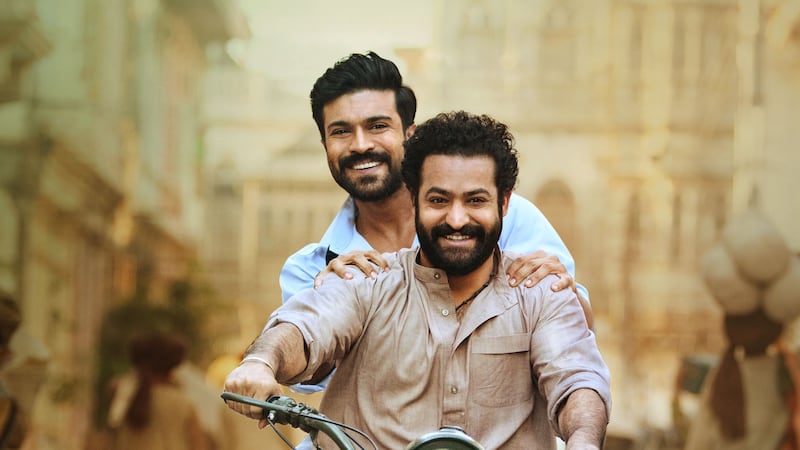Director S.S. Rajamouli sometimes recounts how at his films’ opening weekends in India, audiences throw enough confetti to obscure the screen.
While perhaps not pristine moviegoer conduct, that celebration is fitting. Countless shots in Rajamouli’s latest—the international sensation RRR—display the kind of explosive showmanship meant to pull pure elation out of audiences. In other words, it’s confetti worthy.
RRR, an action epic set during the Indian independence movement, won near-universal acclaim last year and made rare strides into American film culture. Choose your success metric: It’s the third-highest-grossing Indian film ever, it rocks a 95% on Rotten Tomatoes, and Rajamouli won Best Director at the New York Film Critics Circle Awards.
Now, RRR (which stands for “Rise, Roar, Revolt”) is playing Feb. 9 at Cinema 21 and Feb. 8, 12 and 13 at the Hollywood Theatre. While it’s been available on Netflix for the better part of a year, a theater is without question ideal for this three-hour spectacle. All at once, RRR is muscular, musical, hyperviolent, adorable and inspiring, as the spirits of John Woo, James Cameron and Stanley Donen cohabitate in one film.
Set in the 1920s, Rajamouli’s script imagines a fictional collaboration between real-life freedom fighters Alluri Sitarama Raju and Komaram Bheem as they seek to topple British colonizers. Raju (Ram Charan) is a police officer gunning for the rank of Special Officer. Bheem (N.T. Rama Rao Jr.) is a Gond tribal protector trying to rescue a kidnapped girl from the governor’s palace. The two are on a collision course of justice, mistaken identity and profoundly delightful buddy montages.
Measuring RRR’s impact takes some context, so as not to misrepresent its arrival as completely novel. Charan and Rama Rao Jr. are megastars in India. Thanks to his previous two films—the Baahubali epics—Rajamouli is regarded as having initiated a pan-Indian film movement, bringing the cinema of Telugu-speaking Tollywood to the fore of a national film culture that runs deeper than just the Hindi films of Bollywood. (Rajamouli’s Baahubali 2: The Conclusion is the highest-grossing Indian film in U.S. box office history: $20 million to RRR’s second-place $14.5.)
Artistically, though, RRR represents a new high-water mark for Rajamouli. It excels in small part due to its record-breaking budget (the equivalent of $72 million, the highest in Indian film history) and in large part thanks to the performances of Charan and Rama Rao Jr.
One minute, the actors are contorting their physiques into Mr. Universe poses that would make Schwarzenegger blush. Next, they’re sporting thousand-watt grins amid the furious footwork of a dance-off scene that’s gone stratospherically viral and affords the film beautifully timed levity.
Ram and Bheem possess veritable superhero powers while never abandoning the tactile creativity that comes from two people leaping off a bridge while tied to the same rope. Rajamouli’s priorities aren’t breakneck pace or verisimilitude in the action scenes, but indelible image-making. In fact, the film is so ornately shot that even occasionally gummy-looking CGI fits into the painterly grandeur.
There’s an innocence to Ram and Bheem’s bromance, with scenes of motorcycle and piggyback goofery that recall the 1975 classic Sholay. Their earnest affection might make some irony-trained American audiences momentarily laugh at the film, then quickly laugh with it—and pine for that kind of unself-conscious good cheer in Hollywood blockbusters.
While the first 90 minutes contain five of 2022′s best set pieces, RRR’s post-intermission half loses itself temporarily in the mistaken identity conflict between its heroes and a Ram backstory that elides character development and relies on some uncharacteristically bland plot mechanics. Shortly thereafter, though, Bheem chucks a motorcycle at British Special Forces with his bare hands. Script complaints tend to fade at that point.
Given all RRR has achieved, its lone Oscar nomination for Best Original Song (“Naatu Naatu”) might feel like a pittance (India didn’t even submit the film to the Academy as its national entry). Yet Rajamouli’s mad masterwork is playing bonus engagements eight months after its Netflix release in a city more than 7,000 miles from where it was made. It’s already won.
SEE IT: RRR, rated PG-13, plays at Cinema 21 and the Hollywood Theatre.
